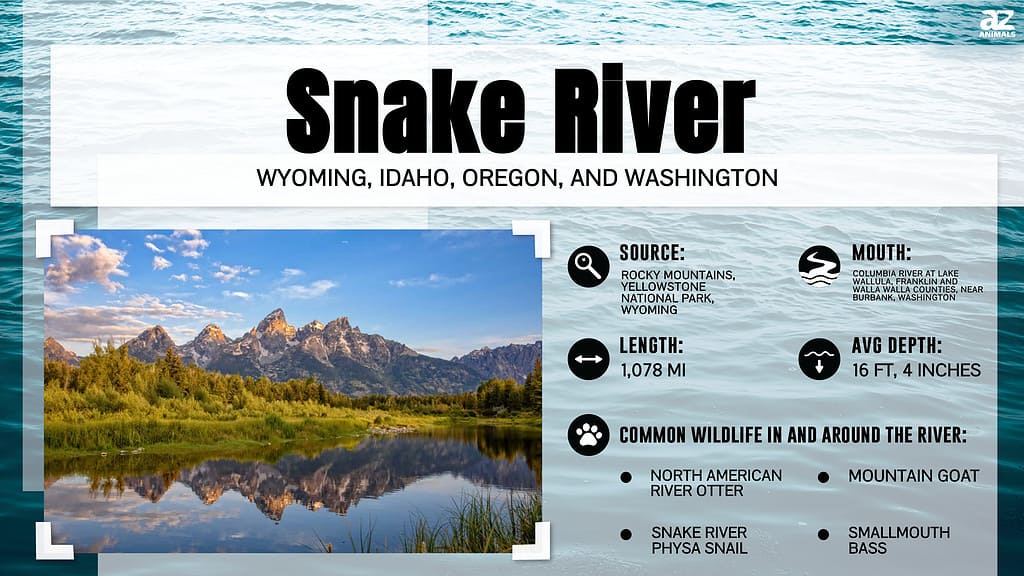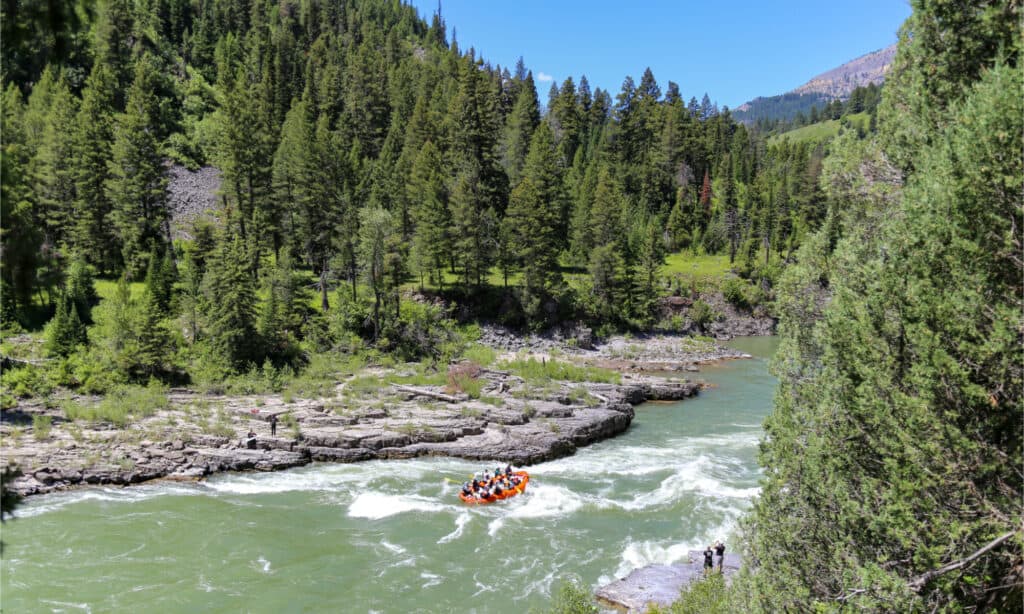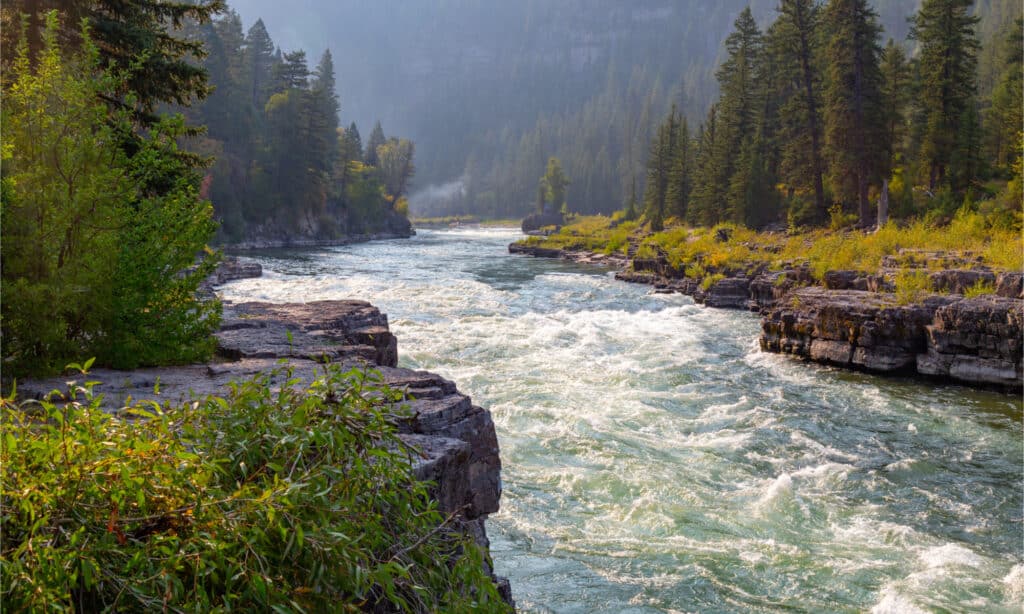
In the Pacific Northwest of the United States, the Snake River is the Columbia River’s largest tributary. The average flow of the river’s waters is about 54,000 cubic feet per second. Because of this, the river is one of our country’s most powerful hydrologic resources. Huge plains, pine forests, red rock canyons, and other varied landscapes are all traversed by the enormous river.
One of the most important rivers in the area, it originates in the Continental Divide mountains at Yellowstone National Park’s southeast corner in Wyoming, travels across Idaho and Oregon, and then empties into the Columbia River in Washington state.
The Snake River is a significant irrigation water supply for crops like potatoes and sugar beets. The river is well-known in the United States, but the question lingers: How deep is the Snake River?
And does it have snakes? This article will discuss the Snake River’s depth, length, and size, how it got its name, and more.
What Depth Is the Snake River?

The Snake River is 16 feet and 4 inches deep.
©Barry Bjork/Shutterstock.com
Rivers are not known to be very deep or as deep as most lakes. On average, the Snake River is 16 feet and 4 inches deep. It may not be the deepest river in the country or the world, but it carves North America’s deepest gorge – Hells Canyon.
Hells Canyon is even deeper than the Grand Canyon and comprises a sizable and isolated area with significant elevation, climate, geography, and vegetation variations.
More than a mile below Oregon’s west border and 8,000 feet below Idaho’s snow-capped He Devil Peak lies Hells Canyon, which the great Snake River carved.
Only three roads point to the Snake River between Hells Canyon Dam and the Oregon-Washington border; there are no highways that span the 10-mile-wide Hells Canyon.
What Determines the Depth of a River?
A river’s depth can vary depending on several variables. For instance, a river flow may have greater erosive strength vertically than horizontally, maintaining a small channel but deepening it.
According to that theory, rivers with a high discharge rate, such as the Amazon River, could release water too quickly for silt to settle, gradually deepening the river.
Of course, geological activity has the potential to change a river’s depth over an extended time or even during its initial development.
How Long Is the Snake River?

Measuring 1,078 miles long, the Snake River is the 13th longest river in the U.S.
©CSNafzger/Shutterstock.com
The Snake River is the thirteenth-longest river in the United States, with a total length of 1,078 miles.
Its watershed, which spans six U.S. states, Nevada, Utah, Oregon, Washington, Wyoming, and Idaho, covers almost 108,000 square miles, ranking it as the tenth-largest among North American rivers, with the largest portion in Idaho.
Most of the Snake River watershed is located between the Rocky Mountains and the Columbia Plateau. The Snake River watershed accounts for around 41% of the basin’s total area, and its typical discharge at the mouth accounts for 31% of Columbia River’s flow.
The Snake River is a bit longer than the Columbia River above the junction, measuring 1,078 miles versus the latter’s 928 miles. Its drainage basin is slightly larger, measuring 4% bigger than the upstream Columbia River watershed. The Snake River is also the largest river in North America to flow into the Pacific Ocean.
Where Does the Snake River Start and End?

The Snake River extends through Eastern Washington’s Palouse Hills as it emerges from Hells Canyon.
©CSNafzger/Shutterstock.com
The Snake River originates in Wyoming and empties into the Columbia River in the country’s Pacific Northwest. Parts of the Grand Teton and Yellowstone National Parks are where the river originates.
The Snake River extends through Eastern Washington’s Palouse Hills as it emerges from Hells Canyon. Eastern Oregon, Southern Idaho, Southeast Washington, and Northwest Wyoming are locations where you can access the Snake River. It is one of the most beautiful aquatic habitats in the West. From Wyoming the river flows across Idaho before reaching its mouth close to the tri-cities of Washington.
Where Is Snake River Located on a Map?
The Snake River marks the 200-mile border between the states of Idaho and Oregon. As the river flows into Hells Canyon, the border does too. Cities by or near the river include Jackson in Wyoming, Ontario in Oregon, and Clarkston and Tri-Cities in Washington, as well as Idaho cities Idaho Falls, Blackfoot, American Falls, Burley, Lewiston, and Twin Falls.
Animals That Live in Snake River

Bald eagles are found near and around Snake River.
©FloridaStock/Shutterstock.com
The Snake River, located in the western United States, is a major river that flows through six states: Wyoming, Idaho, Oregon, Washington, Utah, and Nevada. It is known for its scenic beauty and recreational opportunities, as well as its diverse wildlife.
Here are some of the animals that call the Snake River home:
The Snake River is home to a diverse array of wildlife, from anadromous fish to playful river otters and majestic bald eagles.
These animals are an important part of the river ecosystem and serve as indicators of the health of the river and its surrounding habitats.
Functions of the Snake River
The Snake River performs several functions as one of the most significant rivers in the area. The region’s economy has changed due to the dams that capture the river’s energy.
Over the years, the Snake River has seen numerous changes. Dams serve as small diversion channels or very tall structures. The dams constructed along the river and its tributaries aided the region’s irrigation system and hydroelectric power.
On the Lower Snake River in Washington, there are four significant dams that the U.S. Army Corps of Engineers built and maintained. The four dams are Little Goose, Ice Harbor, Lower Granite, and Lower Monumental. There are also three big hydroelectric dams upstream, close to Hells Canyon, namely Oxbow Dam, Hells Canyon Dam, and Brownlee Dam.
Another use of the Snake River is for water rafting. If you like to experience new things, you should try it. Some of the most thrilling rapids are found in the river’s canyon, and people travel to the canyon from all over the world to board a raft and experience the challenging rapids for themselves. A typical tour often includes an 8-mile section across Hells Canyon.
Are There Snakes in the Snake River?

Summer on the Snake River in Washington State, USA.
©iStock.com/Maxvis
Contrary to its name, the Snake River doesn’t have snakes. But why the name, though? While some people might believe that the river’s name comes from the fact that it resembles a snake in its many twists and turns, the term is really thought to have originated from a Native American hand symbol.
The Snake River was a crucial supply of food for Native Americans living along its banks over 11,000 years ago, particularly the Shoshones. The Shoshone people used hand gestures to let others know when they were close to a river teeming with fish.
But their hand signal was misinterpreted by the settlers. The settlers misunderstood the Shoshone people’s symbolism as a snake. The misunderstanding persisted, and the long river in the United States became known as the Snake River.
The photo featured at the top of this post is © Nagel Photography/Shutterstock.com
Thank you for reading! Have some feedback for us? Contact the AZ Animals editorial team.






